Occupational Environment Monitoring at the ATM Manufacturing Factory
99,000 ₫
Note: The above price is calculated for one sample, and the price may fluctuate depending on the area of the environment to be monitored and market movements. For more accurate pricing support, please refer to the pricing table or contact our consulting staff directly.
Environmental monitoring of an ATM manufacturing factory is a session of collecting, analyzing, and evaluating workplace factors that may be harmful to workers’ health.
Table of Contents
Toggle1. Overview of ATM Manufacturing Factories
a. What is an ATM manufacturing factory?
A manufacturing factory for ATMs is a facility that produces and assembles Automated Teller Machines (ATMs), also known as self-service cash machines. These factories specialize in manufacturing components and parts of ATMs, from display screens, keypads, card readers, receipt printers to hardware and control software. The components are then assembled into complete ATMs, ready for transportation and installation at bank branches or public areas.
ATMs have become an essential part of modern banking and payment systems, enabling users to withdraw cash, check account balances, transfer funds, and perform other banking transactions automatically and conveniently.

b. Production stages in an ATM manufacturing factory
The production stages in an ATM manufacturing factory include:
- Design and development: In this initial stage, teams of engineers and designers research and develop new ATM designs. Functional requirements, user interface, security, and other features are determined.
- Metal processing and fabrication: Metal parts such as the frame, control unit, cash dispenser, and card slot are fabricated from metals like stainless steel or aluminum alloys.
- Electronics assembly: This stage includes assembling electronic components such as printed circuit boards, processors, memory, user interface control circuits, sensors, and other parts. These components are soldered onto the boards to create electronic modules.
- Assembly and inspection: Metal and electronic components are assembled together according to standard procedures. ATMs are assembled from components like display screens, keypads, card readers, receipt printers, and other hardware. After assembly, machines are quality checked to ensure stable operation and compliance with standards.
- Software installation: ATMs are loaded with software to control functions and interact with users. This includes the operating system, transaction applications, and protocols connecting to the banking system.
- Final testing and packaging: After assembly and software installation, ATMs undergo final testing to ensure proper functioning and compliance with quality standards. Complete machines are then packaged, serialized, and prepared for transportation to their deployment locations.

c. Machinery used in ATM manufacturing factories
In ATM manufacturing factories, various machinery is used to carry out production and assembly stages. Common machines include:
- Metal processing machines: Used to cut, bend, weld, and process metal parts such as frames, control units, card slots, and other mechanical components.
- Electronics assembly machines: Used to assemble and solder printed circuit boards, attach electronic components, and test functionality and quality of electronic modules.
- Plastic cutting and processing machines: Used to cut, shape, and process plastic components in ATMs, such as casing, buttons, covers, and protective parts.
- Printing and labeling machines: Used to print and label ATM components, including displays, keypads, card readers, and other parts.
- Quality control and inspection machines: Used to check functionality and ensure ATM quality before packaging and shipping.
- Cash loading and packaging machines: Used to load cash and package complete ATMs before delivery to clients or transport services.

d. Occupational diseases for workers in ATM manufacturing factories
Workers in ATM manufacturing factories may be at risk of certain occupational diseases related to the work environment. Common risks include:
- Nervous system disorders: Exposure to noise and vibrations from machinery can increase the risk of hearing and neurological issues.
- Respiratory diseases: Dust and chemical fumes from production and processing of ATM components can damage the respiratory system, causing pneumonia, asthma, and related illnesses.
- Skin diseases: Contact with chemicals during production can cause skin irritation, dermatitis, eczema, and other dermatological issues.
- Spinal and musculoskeletal disorders: Long-term work in poor ergonomic conditions can lead to spinal and joint problems due to strain and improper posture.
- Work-related stress: High workload, long working hours, and production pressures can lead to stress, affecting workers’ mental and physical health.
To prevent occupational diseases and protect workers’ health, proper labor protection measures, safety guidance, and occupational health monitoring must be implemented and strictly followed.

e. Common types of ATMs on the market
Common types of ATMs include:
- Standard ATMs: Basic machines allowing users to withdraw cash from bank accounts using ATM cards.
- Upgraded ATMs: Enhanced versions of standard ATMs offering features such as cash deposits, balance checking, online transfers, and account statement printing.
- Business ATMs: Used mainly in business environments, providing additional functions such as cash deposits, bill payments, and corporate financial management.
- Mobile ATMs: Portable ATMs used at events, exhibitions, or locations without fixed ATMs, offering cash withdrawal services at various sites.
- Multifunction ATMs: ATMs integrated with additional services such as airline ticket sales, movie ticket sales, mobile top-ups, and other payment services.
2. Overview of occupational environment monitoring services
a. What is occupational environment monitoring in ATM manufacturing factories?
Occupational environment monitoring (or workplace environmental measurement) in ATM manufacturing factories involves collecting, evaluating, and analyzing measurement indicators of workplace environmental factors. This is done to implement timely solutions, minimize environmental hazards affecting workers’ health, and prevent occupational diseases. Occupational environment monitoring is mandatory for ATM manufacturing factories.
This monitoring plays a crucial role in protecting, maintaining, and enhancing workers’ health, as employees are the main workforce directly contributing to the company’s profit. Regular exposure to hazardous factors beyond permitted limits can negatively impact health and cause occupational diseases.
REGISTER FOR OCCUPATIONAL ENVIRONMENT MONITORING SERVICE
b. Nam Viet’s occupational environment monitoring program
Nam Viet’s occupational environment monitoring program is designed by monitoring engineers specializing in occupational safety and environmental protection. To ensure worker safety and health, the program uses modern measurement methods to monitor air quality, water, microclimate, physical factors, dust, and other workplace environmental conditions. This program is crucial for maintaining a safe working environment and protecting employees’ health.
Additionally, the program plays an important role in researching and developing new solutions to improve workplace environmental quality. With the dedication and professionalism of its monitoring experts, Nam Viet’s exclusive monitoring program represents a breakthrough in occupational safety management and environmental protection in Vietnam.

c. Standardization in workplace environmental measurement procedures
Standardization in Nam Viet’s environmental measurement procedures is vital for ensuring the accuracy and reliability of results. The program follows recognized standards and procedures set by the Ho Chi Minh City Department of Health. This ensures collected data can be trusted when assessing the workplace environment and making decisions to improve it and safeguard workers’ health.
These standardized procedures also ensure that results are conducted by highly qualified monitoring specialists with extensive experience, allowing managers and experts to rely on An Toàn Nam Viet’s results and make accurate, valuable decisions for worker health and environmental protection.
By applying standardized procedures in environmental monitoring, Nam Viet demonstrates its commitment to providing a safe working environment and protecting employees, while actively contributing to the improvement of occupational safety and environmental management in Vietnam.
d. Reporting results of occupational environment monitoring in ATM factories
Monitoring results are prepared according to Form No. 04, Appendix III issued with Decree 44/2016/ND-CP and prepared in two copies: one sent to the contracted workplace, and one retained by the monitoring organization.
The retention period for occupational environment monitoring results is unlimited, as prescribed by law.

e. Frequency of occupational environment monitoring as per legal regulations
According to Clause 2, Article 18 of the Labor Safety and Hygiene Law 84/2015/QH13, employers must conduct occupational environment monitoring to assess hazardous factors at least once a year.
f. Deadline for submitting occupational environment monitoring reports according to legal regulations
The submission deadline is before December 31 each year. Businesses in production facilities must submit occupational environment monitoring reports to the local Department of Health where the headquarters or workers are located.
When there are changes in technology, production processes, or renovations/upgrades that may introduce new hazardous factors, businesses must update their occupational health records and conduct monitoring accordingly.
g. Penalties for violations of occupational environment monitoring regulations for employers
According to Article 27 of Decree No. 12/2022/ND-CP dated January 17, 2022, regulating administrative penalties in labor, social insurance, and Vietnamese workers working abroad under contracts:
- Clause 2: A fine of 2,000,000 – 5,000,000 VND for employers who fail to publicly inform workers at the monitoring site and the place where hazardous factors are assessed immediately after receiving the monitoring results and related evaluations.
- Clause 3: A fine of 20,000,000 – 40,000,000 VND for employers who fail to conduct occupational environment monitoring to control hazards affecting workers’ health according to the law.
- Clause 4: A fine of 40,000,000 – 60,000,000 VND for employers who cooperate with monitoring organizations to commit fraud in environmental monitoring activities without reaching the level of criminal prosecution.
3. Harmful environmental factors for workers in ATM manufacturing factories
Harmful environmental factors that may exist in an ATM manufacturing factory include:
- Noise: Machinery and equipment in the factory can produce high levels of noise, especially during metal processing and assembly operations. Noise can cause stress, fatigue, and negatively affect workers’ health.
- Metal dust: Metal processing and handling can generate metal dust such as aluminum, iron, or steel dust. Inhaling metal dust can lead to pneumonia, lung diseases, and other respiratory problems.
- Chemicals: Some processes in ATM production may use chemical compounds such as solvents, cleaning agents, adhesives, and coatings. Exposure to these chemicals can irritate the skin, eyes, and respiratory system, and in severe cases, may cause serious health issues.
- Temperature and humidity: The working environment in an ATM manufacturing factory may have high temperature and humidity due to machinery and equipment operation. This can cause discomfort, fatigue, and reduce worker productivity.
- Lighting: Some areas in the factory may have strong glare from lighting fixtures or other equipment. Glare can cause eye strain, visual fatigue, and affect workers’ vision.
REGISTER FOR OCCUPATIONAL ENVIRONMENTAL MONITORING SERVICE
4. Measures to improve the working environment in ATM manufacturing factories
To improve the working environment in ATM manufacturing factories and minimize harmful factors for workers, the following measures can be applied:
- Noise management: Apply technical measures such as soundproofing, insulation, and acoustic materials to reduce noise from machinery and equipment. Additionally, provide employees with protective headphones and ear protection to mitigate harmful noise exposure.
- Dust and chemical management: Ensure effective dust extraction systems to remove metal dust and waste from the air. Implement chemical control measures such as using environmentally friendly chemicals and ensuring safe working procedures, including wearing personal protective equipment and handling chemicals in well-ventilated areas.
- Temperature and humidity control: Provide air conditioning systems or ventilation fans to regulate temperature and humidity in the factory. Ensure proper airflow and ventilation to minimize damp conditions and maintain a comfortable working environment.
- Lighting improvement: Ensure appropriate lighting levels in work areas. Use efficient lighting fixtures and arrange lighting to avoid glare, creating a comfortable work environment for employees.
- Training and supervision: Provide occupational safety and health training for employees working in the factory. Ensure compliance with safety and hygiene regulations, and conduct regular supervision to maintain a safe and healthy working environment.
- Information and communication: Provide adequate information and maintain effective communication between employees and management to identify and address workplace environmental issues.
- Regular inspection and maintenance: Conduct periodic inspections and maintenance of equipment, machinery, and systems in the factory to ensure safe and efficient operation.
- Periodically organize occupational environmental monitoring in factories, collect and analyze harmful factors affecting workers, and adjust conditions to reduce hazards and prevent occupational diseases.
5. Benefits of periodic monitoring in ATM manufacturing factories
An Toan Nam Viet provides businesses with excellent benefits when using occupational environmental monitoring services in accordance with Decree 44/2016/ND – CP on the management and control of harmful factors in the working environment affecting workers.
- Businesses can proactively control harmful factors in workshops or factories.
- Receive advice and recommendations on measures to reduce harmful factors and improve the quality of the working environment.
- Indirectly protect human resources, the key factor in business development.
- Reduce the impact of occupational diseases on human health, thereby minimizing future treatment costs.
- Improved worker health leads to better product quality and stable production output.
- Ensure compliance with labor safety laws, avoiding legal risks.
- Enhance reputation and professionalism in all aspects, thereby elevating the business’s brand.
Nam Viet’s environmental monitoring service is a solution to minimize the impact of occupational diseases, contributing to a clean and high-quality working environment.

6. National occupational environmental monitoring center
Occupational Environmental Monitoring Center of Nam Viet is a professional unit for monitoring and measuring the quality of the working environment throughout all provinces and cities in Vietnam. With a team of experienced monitoring specialists, the center uses modern measuring equipment to ensure accuracy and reliability.
In addition to providing monitoring services, the center assists customers in planning, handling, and tracking occupational environmental issues. With the motto “customer-centered,” the center prioritizes customer satisfaction, meets all customer needs, and is committed to providing the best solutions for businesses.
REGISTER FOR OCCUPATIONAL ENVIRONMENTAL MONITORING SERVICE
With investments in technology, equipment, and human resources, Nam Viet’s monitoring center has become a reputable unit in the field of occupational environmental monitoring in Ho Chi Minh City with the following objectives:
- We always value our brand reputation and the quality of our service products.
- We provide customers with the best and most suitable solutions possible.
- Together with a team of experienced Masters and Engineers, we aim to protect the environment and benefit businesses.
- By working with Nam Viet Environmental Monitoring team, companies receive professional services from experts and the best cost advantages.
The occupational environmental monitoring process at Nam Viet includes the following basic steps:
- Before conducting monitoring, our company ensures all machinery and equipment are adjusted and calibrated according to legal regulations.
- Strictly implement the occupational environmental monitoring procedures as committed to the Department of Health.
- Accurately report occupational environmental monitoring results to employers.
- If monitoring results indicate unsafe conditions for workers, Nam Viet will provide remedial solutions, and the employer will implement the following:
- Apply measures to improve working conditions to minimize harmful factors and prevent occupational diseases.
- Organize health checks to detect early occupational and work-related illnesses for workers in unsafe environments.
- Provide material compensation for workers according to labor laws.

7. Occupational environmental monitoring service quotation
To help businesses conduct occupational environmental monitoring professionally and effectively, Nam Viet provides customers with a high-quality and reasonably priced service quotation for occupational environmental monitoring.
- Our quotation provides detailed information on the costs of the monitoring services offered, including transportation, measurement, analysis, and reporting fees. Customers can be fully assured of the accuracy and reliability of the monitoring reports we provide.
- We commit to offering the most competitive and reasonable prices on the market and are always ready to promptly answer all questions regarding monitoring services professionally.
- With Nam Viet’s quotation, customers can easily choose service packages that meet their needs. We are committed to delivering the highest satisfaction with professional service quality.
No comments yet

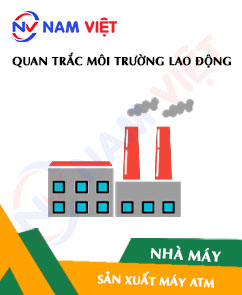
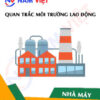
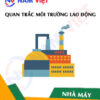



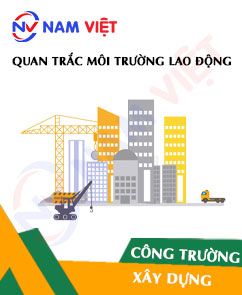

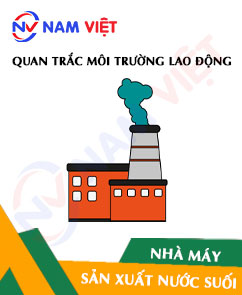


Review Occupational Environment Monitoring at the ATM Manufacturing Factory
There are no reviews yet.